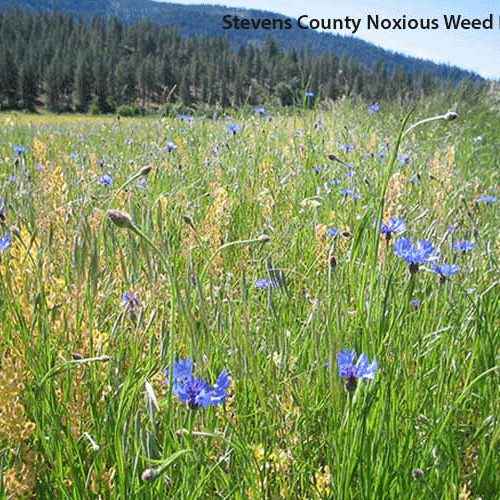Bachelor’s Button
Centaurea cyanus

Family: Asteraceae
Other Common Names: cornflower
Weed class: monitor list
Year Listed: 2012
Native to: parts of Asia and Europe
Is this Weed Toxic?:
not known to be
Why Is It a Noxious Weed?
This plant is on the monitor list - it is not a listed noxious weed in Washington. Please contact its sponsor Adam Pfleeger at adam.pfleeger@co.chelan.wa.us to report locations or for more information.
How would I identify it?
General Description
Bachelor’s button is an annual or winter annual, covered in grayish hairs, growing to around 3-4 feet tall (1.2 meters). Flowers can vary in color from white to purple to blue.
Flower Description
Flowerheads are greater than 1 inch in diameter with bracts at the base, having lacerated, fringed margins (teeth around 1 mm). Flowers are typically blue, though can also be purple, pink, red, or white. Marginal flowers in the flowerhead have enlarged, irregular corollas, somewhat bell-shaped.
Leaf description
Leaves are narrow, generally with smooth leaf edges, though lower leaves are occasionally toothed or lobed along the margins. Leaves at the base 1.2-3.9 inches (3–10 cm) long, stem leaves usually not much smaller except among the flowerheads.
Stem description
Plants typically have one main stem that is branched toward the tip.
Fruit Seed Description
Seeds (cypselae) are straw or pale blue in color, 4-5 mm long, finely hairy with bristles attached to one end that are 2-4mm long.
Where does it grow?
Bachelor's button has naturalized over much of the United States, escaping cultivation as an ornamental and can be found in a variety of habitats including grasslands, woodlands, forests, roadsides and other disturbed sites.
How Does it Reproduce?
Bachelor's button reproduces by seed.
How Do I Control It?
Please refer to the PNW Weed Management Handbook, or contact your county noxious weed coordinator.
For More Information
Images and information from the Invasive Plant Atlas of the United States on Centaurea cyanus
WTU image database for Centaurea cyanus
Flora of North America description of Centaurea cyanus






